There’s something irresistible about a slice of German chocolate cakea perfect harmony of moist chocolate cake layers, rich coconut-pecan frosting, and a deep, buttery flavor. Whether you’re baking from scratch or simply curious about this classic dessert, you’re in for a treat.
German chocolate cake isn’t actually from Germany. It has a fascinating history rooted in American baking traditions. In this guide, we’ll explore its origins, key ingredients, step-by-step baking instructions, and even creative variations. Plus, we’ll answer common baking questions and share expert tips to ensure you achieve the perfect cake every time.
Now, let’s dive into the history behind this iconic dessert!
What is German Chocolate Cake?
German chocolate cake is a layered chocolate cake known for its signature coconut-pecan frosting. Unlike regular chocolate cake, which is often covered in buttercream or ganache, this version has a uniquely textured topping made from sweetened coconut, crunchy pecans, and a creamy caramel-like sauce.
Traditionally, the cake itself is lighter in color than typical chocolate cakes, offering a mild yet rich chocolate taste. Some variations include an extra layer of chocolate frosting, but the true star remains the decadent coconut-pecan filling.
The Origins: Why It’s Not Actually German
Here’s where things get interesting! German chocolate cake has nothing to do with Germany itself. Instead, it was named after Samuel German, an English-American chocolatier who developed a type of dark baking chocolate for the Baker’s Chocolate Company in 1852.
Over a century later, in 1957, a Texas homemaker, Mrs. George Clay, submitted a recipe for German’s Chocolate Cake to a newspaper. The recipe quickly gained popularity, and as it spread, the apostrophe in “German’s” was dropped, leading many to believe it was a German dessert.
How It Became an American Classic
After the original recipe was published, Baker’s Chocolate saw a surge in sales, and German chocolate cake became a household favorite. Over time, bakers across the country experimented with different versions some adding extra layers, some modifying the frosting—but the signature combination of sweetened coconut, pecans, and rich chocolate cake has remained unchanged.
Today, this dessert is a staple for birthdays, holidays, and special occasions. Whether you’re making it from scratch or trying a bakery version, one thing’s for sure: this cake is a timeless classic worth savoring!
Key Ingredients for an Authentic German Chocolate Cake
Chocolate Selection: Why “German’s” Chocolate Matters
One of the most essential ingredients in a German chocolate cake is the chocolate itself. Unlike regular dark or milk chocolate, this cake traditionally uses German’s Sweet Chocolate, a mild, slightly sweeter baking chocolate developed by Samuel German. If you can’t find this specific brand, you can substitute it with a mix of semi-sweet chocolate and a little extra sugar.
The type of chocolate you use directly affects the cake’s flavor so don’t skip on quality! A rich, smooth chocolate ensures a deep, balanced taste in every bite.
Coconut-Pecan Frosting: The Heart of the Cake
No German chocolate cake is complete without its iconic coconut-pecan frosting. This thick, caramel-like topping is made by simmering evaporated milk, sugar, egg yolks, and butter until it thickens, then mixing in shredded coconut and toasted pecans.
The frosting adds a chewy, nutty texture that perfectly complements the soft cake layers. Some bakers also add a pinch of sea salt to enhance the flavor.
Flour, Eggs, and Buttermilk: The Essential Base
The foundation of a great German chocolate cake lies in its moist, tender crumb. This is achieved by using:
- All-purpose flour for structure
- Eggs for richness and stability
- Buttermilk for moisture and a slight tang
The acidity in buttermilk helps activate the baking soda, making the cake extra soft. If you don’t have buttermilk, you can make your own by adding a tablespoon of lemon juice or vinegar to regular milk.
Common Ingredient Substitutes
- No buttermilk? Use milk mixed with vinegar.
- No German’s chocolate? Use semi-sweet chocolate and a teaspoon of sugar.
- Nut-free option? Swap pecans for sunflower seeds or omit them entirely.
By choosing the right ingredients, you set the stage for a perfectly balanced, rich, and decadent cake. Now, let’s get baking!
Step-by-Step Guide to Making German Chocolate Cake
Preparing the Cake Batter: Mixing the Perfect Base
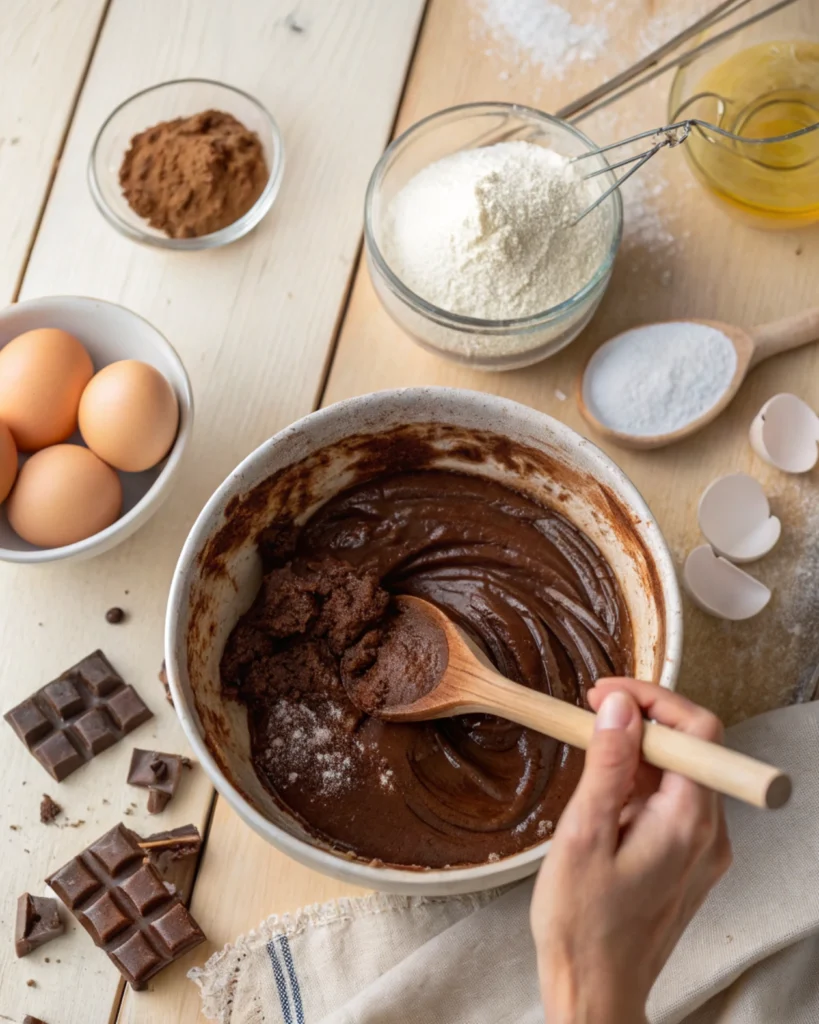
The first step in making German chocolate cake is mixing the batter correctly. Here’s how to do it:
- Combine the dry ingredients – In a large bowl, whisk together flour, cocoa powder, baking soda, baking powder, and salt.
- Mix the wet ingredients – In another bowl, beat eggs, sugar, buttermilk, oil, and vanilla extract until smooth.
- Combine and stir – Slowly add the dry ingredients to the wet mixture, stirring gently to avoid overmixing.
- Add boiling water – This may seem odd, but adding hot water enhances the cocoa flavor and gives the batter a smooth consistency.
At this point, the batter should be thin but silky. That’s completely normal!
Baking Techniques for a Moist Cake
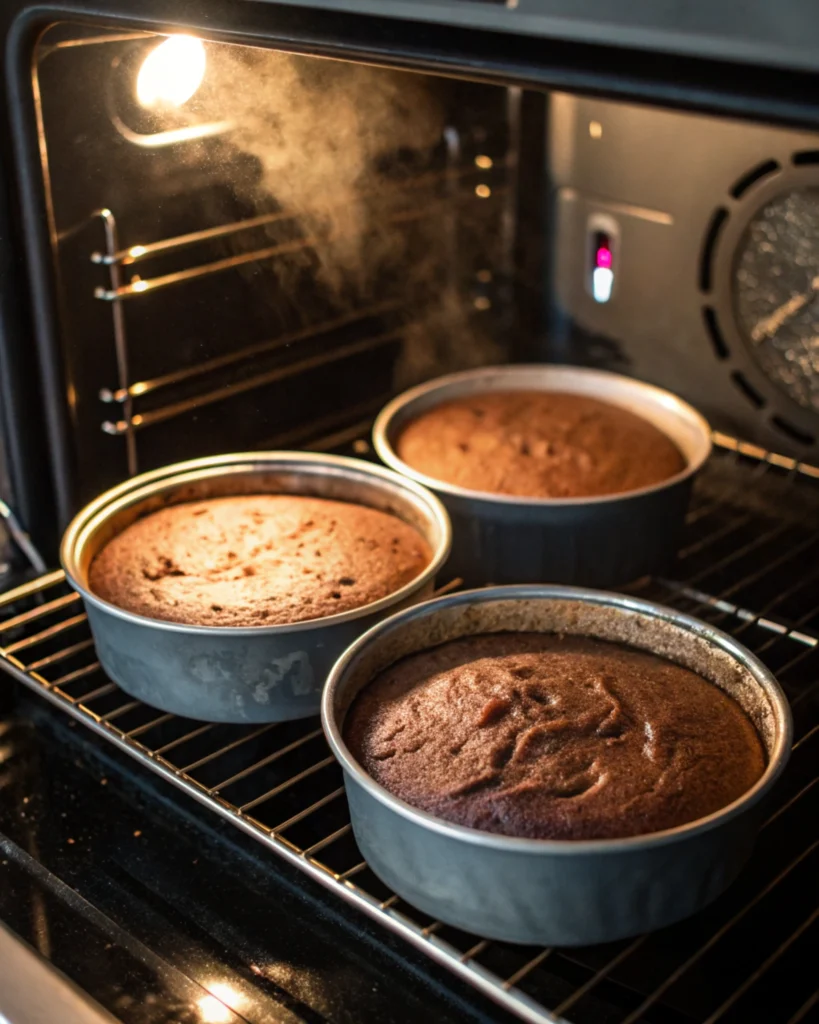
Preheat your oven to 350°F (175°C) and prepare three 9-inch round cake pans by greasing and lining them with parchment paper. Pour the batter evenly into the pans and bake for 25-30 minutes or until a toothpick inserted in the center comes out clean.
Pro tip: If your cakes tend to dome in the center, wrap the pans with cake strips before baking. This helps the layers bake evenly.
Once done, let the cakes cool in their pans for 10 minutes, then transfer them to a wire rack to cool completely before frosting.
Making the Coconut-Pecan Frosting
While the cake cools, prepare the signature frosting:
- In a saucepan over medium heat, whisk together evaporated milk, sugar, butter, and egg yolks.
- Stir constantly until the mixture thickens (about 10-12 minutes).
- Remove from heat and stir in vanilla extract, shredded coconut, and toasted pecans.
- Let the frosting cool completely before using.
The frosting will thicken further as it cools, making it easier to spread and layer.
Assembling and Frosting the Cake
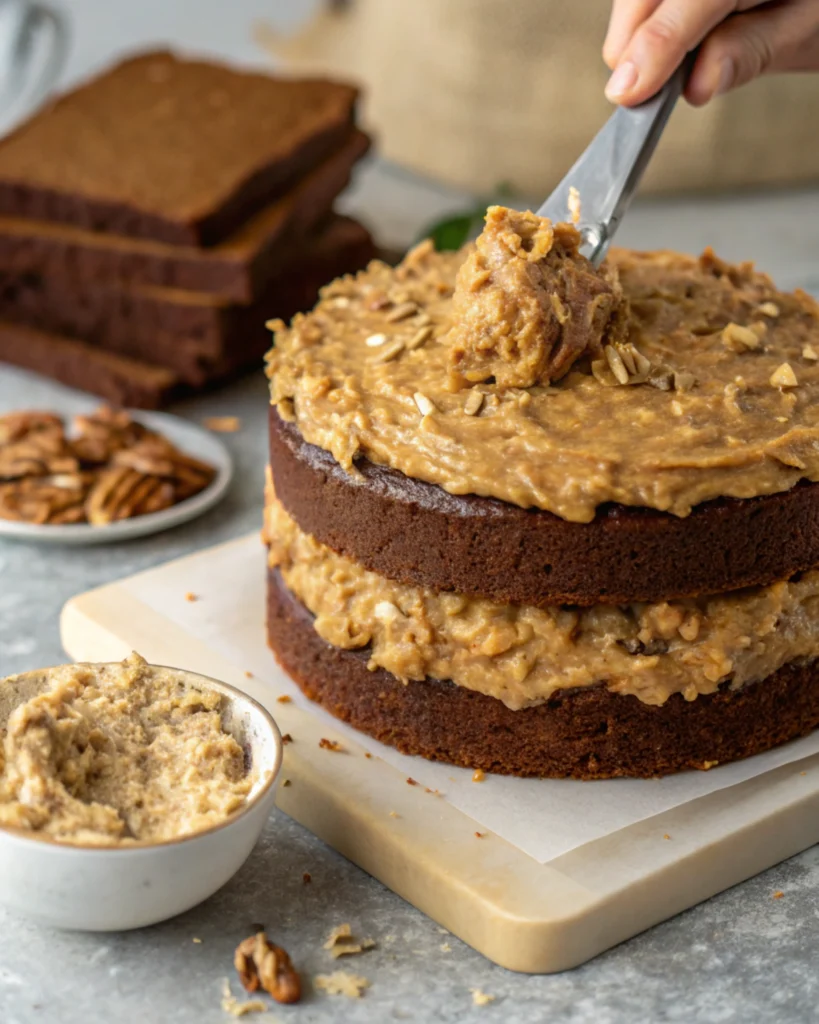
Now for the fun part—putting it all together!
- Place the first cake layer on a plate or cake stand.
- Spread a generous layer of coconut-pecan frosting on top.
- Add the second cake layer and repeat the process.
- Frost the top of the final layer and smooth it out.
Optional: Some people like to coat the sides with chocolate buttercream for an extra chocolatey finish.
Now, your homemade German chocolate cake is ready to be enjoyed! Up next, we’ll explore fun variations and creative twists on this classic recipe. Stay tuned! 😊
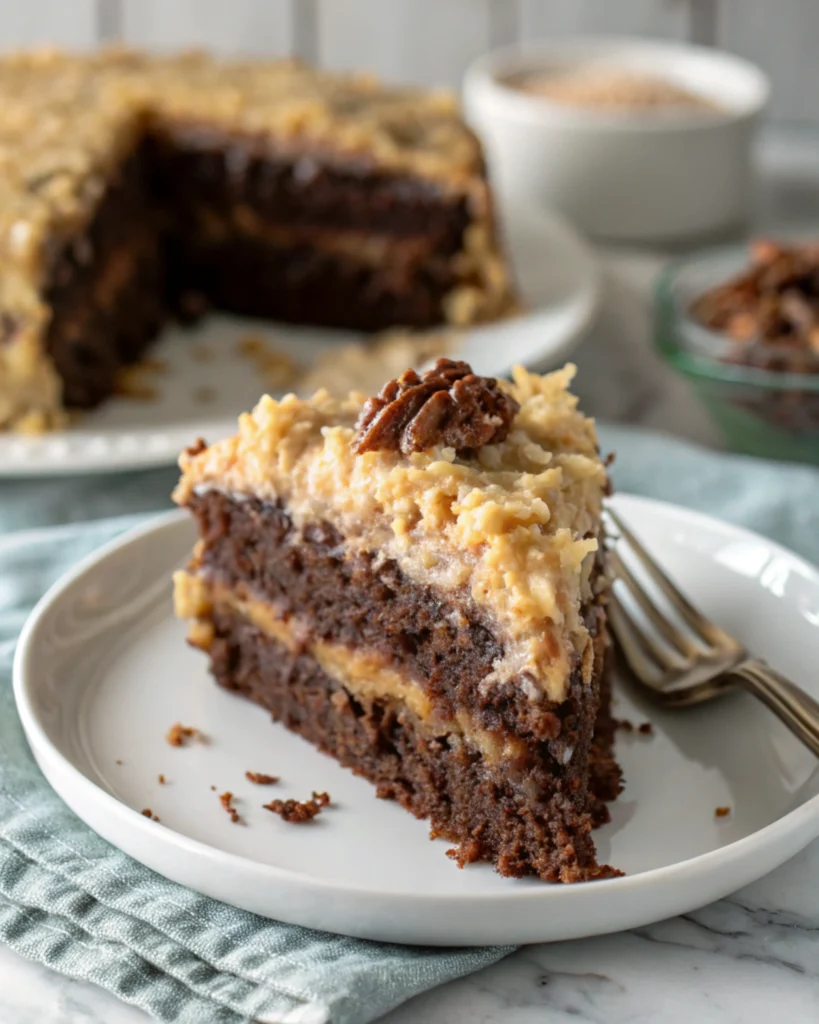
Variations and Modern Twists on German Chocolate Cake
German Chocolate Cupcakes: A Bite-Sized Delight
Love the flavors of German chocolate cake but want a smaller, more convenient treat? German chocolate cupcakes are the perfect solution! These cupcakes use the same rich chocolate batter but are baked in muffin tins for individual servings.
To make them:
- Prepare the batter using the same method as the full-sized cake.
- Line a muffin pan with cupcake liners and fill each about two-thirds full.
- Bake at 350°F (175°C) for 18-20 minutes or until a toothpick comes out clean.
- Cool completely before adding the coconut-pecan frosting on top.
These mini versions are great for parties or when you want a portion-controlled indulgence!
Gluten-Free and Vegan Options
For those with dietary restrictions, you don’t have to miss out on German chocolate cake!
- Gluten-Free Version: Substitute gluten-free all-purpose flour for regular flour and ensure all other ingredients are certified gluten-free.
- Vegan Version: Replace eggs with flax eggs, buttermilk with almond milk + vinegar, and butter with coconut oil or plant-based butter. Use a dairy-free caramel sauce in place of evaporated milk for the frosting.
With these simple swaps, you can still enjoy the classic flavors in a way that suits your diet!
Alternative Fillings and Toppings
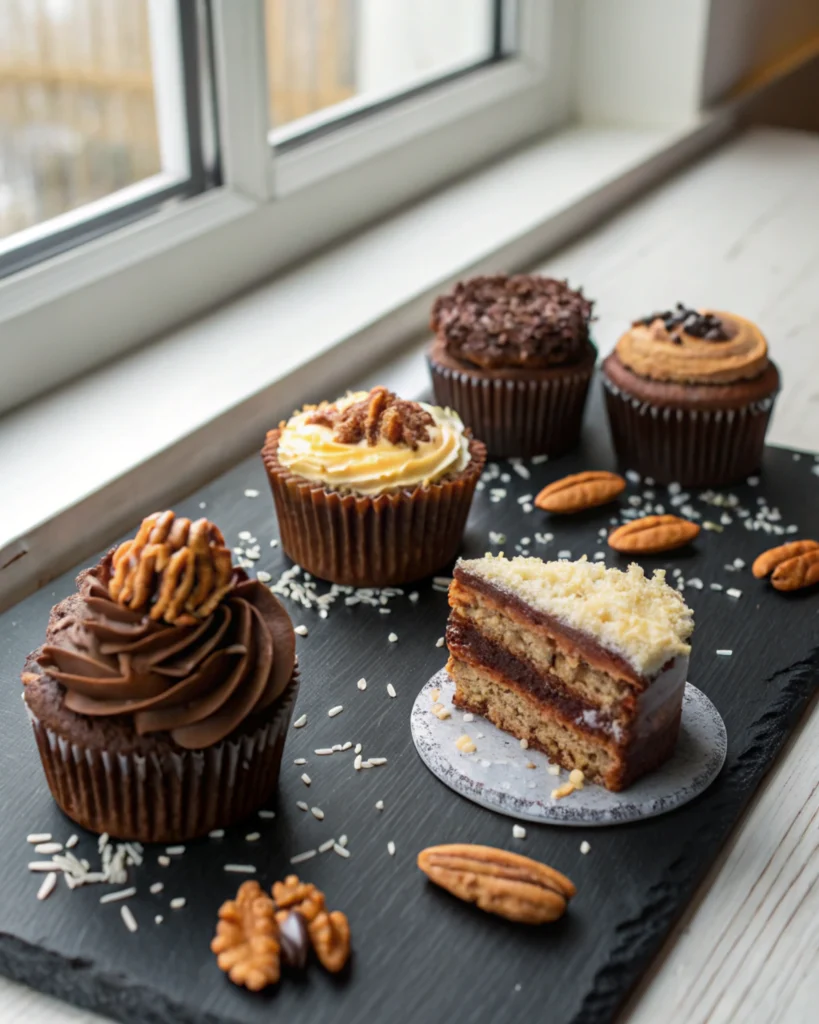
Want to put a unique spin on your German chocolate cake? Try these variations:
- Extra Chocolatey: Add a layer of chocolate ganache between the cake layers for a richer taste.
- Nut-Free: Replace pecans with toasted sunflower seeds or omit them entirely.
- Boozy Kick: Stir in a splash of bourbon or rum into the frosting for an adult-friendly twist.
These creative adaptations keep the cake exciting while staying true to its classic charm!
If you love rich, chocolatey desserts like German chocolate cake, you might also enjoy this fudgy brownie recipe, which delivers deep chocolate flavor with a chewy, melt-in-your-mouth texture.
Common Mistakes and Troubleshooting
Why Did My Cake Turn Out Dry?
A dry cake is disappointing, but it’s often caused by one of these mistakes:
- Overbaking – Check your cake a few minutes before the recommended time.
- Not Enough Moisture – Make sure to use buttermilk and oil, which add richness.
- Too Much Flour – Spoon and level your flour instead of scooping to avoid excess.
To fix a slightly dry cake, brush the layers with simple syrup or chocolate milk before frosting. This adds moisture and enhances flavor.
How to Fix Runny or Too Thick Frosting
If your coconut-pecan frosting is too thin, try these fixes:
- Cook it a little longer to let the liquid evaporate.
- Stir in extra shredded coconut or powdered sugar to thicken.
If the frosting is too thick, add a splash of warm evaporated milk and mix well.
Layering and Decorating Like a Pro
Struggling to stack and frost your German chocolate cake neatly? Here’s how to get a bakery-worthy finish:
- Use chilled cake layers – Cold cake is easier to handle and less likely to crumble.
- Apply a thin crumb coat – Spread a light layer of frosting over the cake and refrigerate for 15 minutes before adding the final layer.
- Use a turntable – This makes spreading the frosting smooth and even.
With these troubleshooting tips, you’ll have a perfectly textured, visually stunning German chocolate cake every time!
Storing and Freezing German Chocolate Cake
Best Practices for Storing at Room Temperature
If you plan to enjoy your German chocolate cake within a couple of days, storing it at room temperature is the best option. Keep the cake covered with a cake dome or an airtight container to prevent it from drying out. Since the coconut-pecan frosting contains dairy, it’s best to consume the cake within two days if left out.
For extra freshness, place a piece of wax paper against any cut edges. This helps retain moisture and prevents the cake from becoming stale.
How to Refrigerate Without Losing Moisture
Need to store your cake for longer? Refrigeration is an option, but it must be done correctly. Follow these steps to maintain its soft texture:
- Wrap the cake tightly with plastic wrap or store it in an airtight container.
- Keep it in the fridge for up to five days.
- Before serving, let the cake sit at room temperature for 30-45 minutes to soften.
Freezing Tips for Long-Term Storage
Want to save your German chocolate cake for later? Freezing is a great way to extend its shelf life.
- For whole cakes: Wrap each layer in plastic wrap and foil before freezing for up to three months.
- For slices: Wrap individual slices and place them in a freezer-safe bag for easy grab-and-go servings.
To thaw, let the cake sit in the fridge overnight or at room temperature for a few hours.
FAQs – Answering the Most Common Questions
Why do they call it German chocolate cake?
The name German chocolate cake is misleading because it’s not actually from Germany. The cake was named after Samuel German, an American chocolatier who created German’s Sweet Chocolate in 1852.
The recipe gained popularity in 1957 when a Texas homemaker submitted it to a newspaper. Over time, the name lost the apostrophe in “German’s,” leading to the misconception that it’s a German dessert.
What is the misconception about German chocolate cake?
Many people believe German chocolate cake originated in Germany. However, the dessert is 100% American and was first published in a Dallas newspaper. The confusion comes from its name, which refers to Samuel German’s baking chocolate, not the country.
Additionally, some assume it’s just a regular chocolate cake, but the coconut-pecan frosting makes it unique. This sets it apart from traditional chocolate cakes that use buttercream or ganache.
What’s the difference between German chocolate cake and regular chocolate cake?
While both cakes are chocolate-based, there are key differences:
- German chocolate cake is lighter in color and milder in chocolate flavor. It uses sweet baking chocolate instead of dark cocoa.
- The signature coconut-pecan frosting makes it stand out. Regular chocolate cakes often use buttercream or ganache.
- It has a softer, more tender crumb due to the use of buttermilk and eggs.
What frosting is used on German chocolate cake?
Unlike regular chocolate cakes, German chocolate cake features a rich coconut-pecan frosting. This frosting is made by cooking evaporated milk, sugar, egg yolks, butter, shredded coconut, and chopped pecans until thick and caramel-like.
Some bakers also add a layer of chocolate buttercream frosting to coat the sides, but the classic version focuses on the coconut-pecan topping.
Final Thoughts
Why German Chocolate Cake Remains a Classic
From its rich history to its unique flavor profile, German chocolate cake has stood the test of time. Unlike standard chocolate cakes, its signature coconut-pecan frosting adds a chewy, nutty contrast that sets it apart. The combination of sweet baking chocolate, buttermilk, and a moist, tender crumb makes every bite unforgettable.
Whether enjoyed at birthdays, holidays, or just as a weekend treat, this cake continues to be a favorite among dessert lovers. Its balance of sweetness, texture, and deep chocolate flavor is hard to beat.
Encouraging Readers to Try Their Own Variations
Baking is all about creativity! While the classic German chocolate cake recipe is delicious on its own, don’t be afraid to experiment. Try making cupcakes, gluten-free versions, or adding a layer of chocolate ganache for an extra indulgent touch.
Now that you know everything about this beloved cake, why not give it a try? Your perfect homemade slice is just a bake away!
Additional Resources and Recipe Recommendations
More Chocolate Cake Recipes to Explore
If you’re a fan of German chocolate cake, you might also love trying other decadent chocolate desserts. Here are a few suggestions:
- Classic Chocolate Layer Cake – A rich, fudgy delight with buttercream frosting.
- Molten Lava Cake – Perfect for those who love a gooey, melty chocolate center.
- Chocolate Cheesecake – A creamy and indulgent twist on traditional cheesecake.
Looking for more easy and delicious cake recipes? Check out this strawberry cheesecake dump cake, a simple yet irresistible dessert packed with creamy, fruity goodness.
For a tropical twist on classic cakes, try this Hawaiian carrot pineapple cake a moist, fruity dessert with warm spices and a hint of citrus.
Final Baking Tips for Success
Before you start baking, keep these expert tips in mind:
- Measure ingredients accurately – Baking is a science, and precision matters.
- Use high-quality chocolate – The better the chocolate, the richer the flavor.
- Let the cake cool completely before frosting – This prevents melting and mess.
For more delicious dessert ideas, stay tuned for upcoming recipes and baking tips. Happy baking!
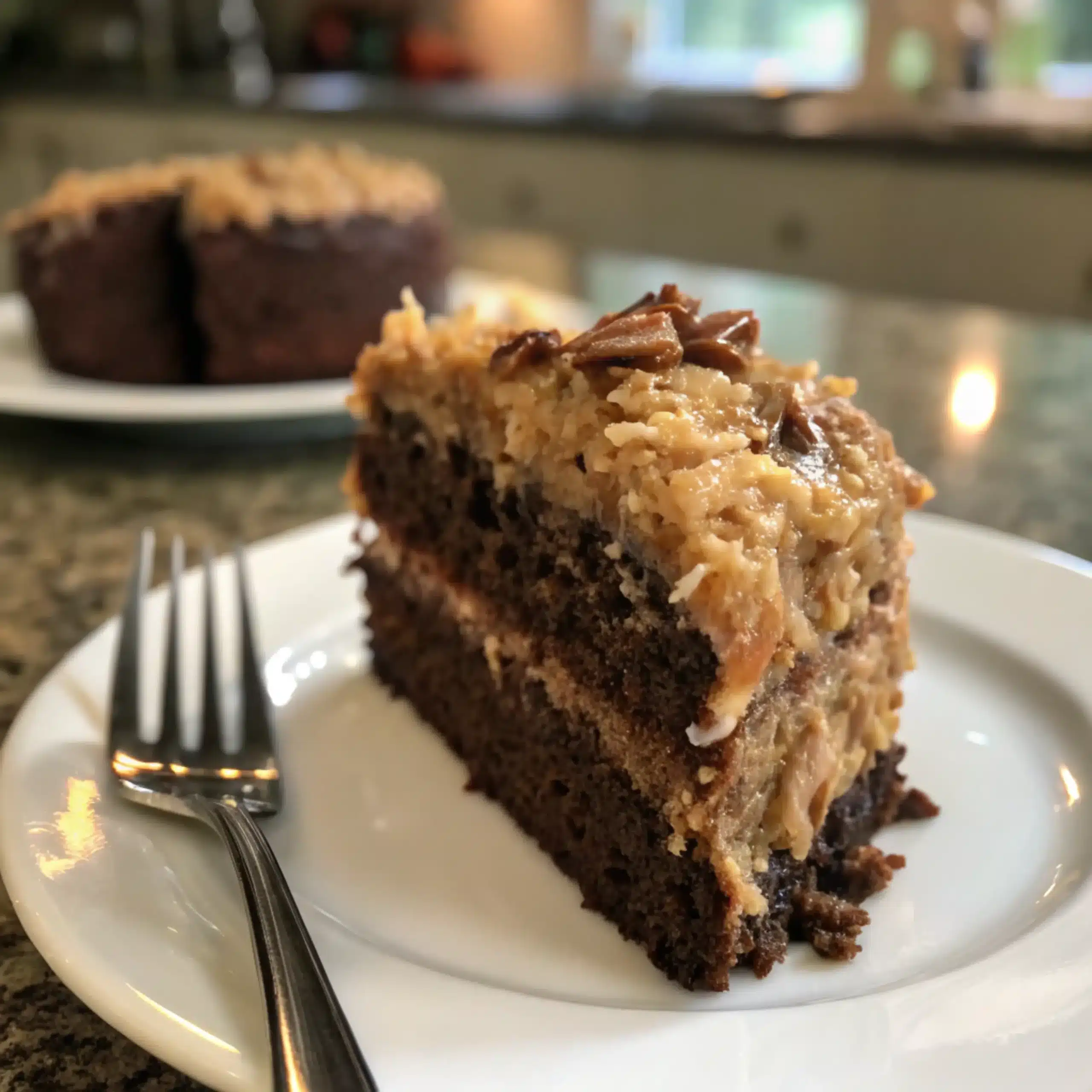
German Chocolate Cake
Ingredients
Equipment
Method
- Preheat oven to 350°F (175°C). Grease and line three 9-inch round cake pans with parchment paper.
- In a large bowl, whisk together the flour, cocoa powder, baking soda, baking powder, salt, and sugars.
- In another bowl, beat the eggs, buttermilk, vegetable oil, and vanilla extract until smooth.
- Gradually add the dry ingredients to the wet ingredients, stirring gently until combined.
- Stir in the boiling water until the batter is smooth. The batter will be thin.
- Divide the batter evenly between the prepared cake pans and bake for 25-30 minutes, or until a toothpick inserted in the center comes out clean.
- Allow the cakes to cool in the pans for 10 minutes before transferring to a wire rack to cool completely.
- To make the frosting, heat evaporated milk, sugar, butter, and egg yolks in a saucepan over medium heat, stirring constantly until thickened (about 10-12 minutes).
- Remove from heat and stir in vanilla extract, shredded coconut, and toasted pecans. Let cool completely before using.
- To assemble the cake, place one layer on a serving plate and spread a generous amount of coconut-pecan frosting on top. Repeat with the remaining layers.
- Frost the top of the final layer, smoothing it out. Serve and enjoy!

